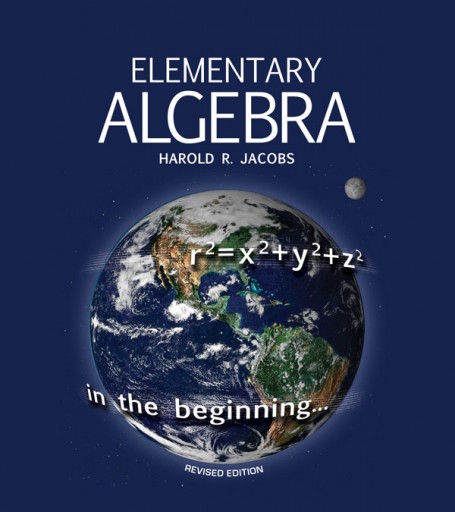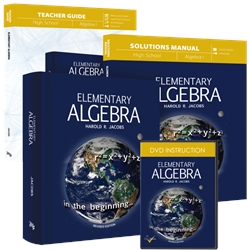Elementary Algebra by Harold R. Jacobs is an atypical algebra text that has been around for almost forty years in essentially the same edition because it has been so popular. It was just republished in 2016 by Master Books, and some minor changes were made to the course which I will describe later.
Elementary Algebra covers all concepts typical of a first-year algebra course, but it invites students to explore algebra concepts in a friendlier environment than other texts. Cartoons, comic strips (e.g., Broom Hilda, B.C., Wizard of Id, and Doonesbury), interesting and creative applications, puzzles, and even poetry capture the interest of students who struggle with abstract mathematics. For example, a lesson on mixture problems opens with the story of Archimedes and the King of Syracuse’s golden crown which the king suspected was not really solid gold. Jacobs then sets up a volume and weight equation based on the problem.
In addition to stories and practical applications, Jacobs uses the rectangle-building (or area-model) concept throughout the text to demonstrate how concepts work. This is the same rectangle building idea used by Math-U-See and some other manipulative systems. While Jacobs’ book shows pictures, not requiring the use of manipulatives, students can still use manipulatives if they are helpful. I think most students should really benefit from this approach when they are learning to multiply and factor polynomials. (This last feature makes this text a particularly good one to use after Math-U-See’s Pre-Algebra level. If you don’t already have manipulatives, you might want to check out the Algebra Tiles from Nasco.)
The hardcover textbook is divided into seventeen chapters, with each chapter subdivided into a number of lessons. Students should be able to read through the instructional material and examples on their own, working independently most of the time. If your student benefits from a teacher's presentation, you might want to get the optional DVD Instruction set. These six DVDs have about six hours of lesson presentation by Dr. Callahan.
In the original book, there were four exercise sets at the end of each lesson. The first set reviews concepts from earlier lessons along with some from the current lesson. The second set concentrates primarily on topics taught in the current lesson. The third set of problems is generally fairly similar to the second set. These three sets present problems ranging from simple computation through word and application problems. The most challenging problems are in the fourth set. These are often complex problems requiring critical thinking skills. Since the third set is similar to the second set in the level of difficulty, Master Books has removed the third set of problems from the textbook. They have put those sets in the teacher guide, so they are still available for those who might want to use them. Generally, you will have students work through at least the first two sets of problems. By assigning appropriate problems, you can use the text with students of varying capabilities. Answers to the second set from each lesson are in the back of the student text so students can see if they are getting the correct answers. (If students are tempted to look at answers ahead of time, you might assign problems from the third set instead.)
Each chapter concludes with a "Summary and Review" section that briefly summarizes key concepts. This is followed by two sets of problems that review concepts from the entire chapter. The text includes answers for only one of these sets of chapter review problems. The teacher’s guide is the source for the rest of the answers for chapter reviews as well as the answers for the first, third, and fourth problem sets from the lessons. The teacher guide also has tests and test answer keys. A complete solutions manual is also available for students who need help figuring out what steps they have missed when they can't solve a problem.
The student text and the teacher guide are the most critical components, but if you want the solutions manual or the DVDs, you will save purchasing either the curriculum pack with the textbook, teacher guide, and solutions manual or the curriculum pack that also includes the set of DVDs.
Jacob's Elementary Algebra provides solid coverage of first-year algebra and remains one of the easiest courses for students to use and understand.











